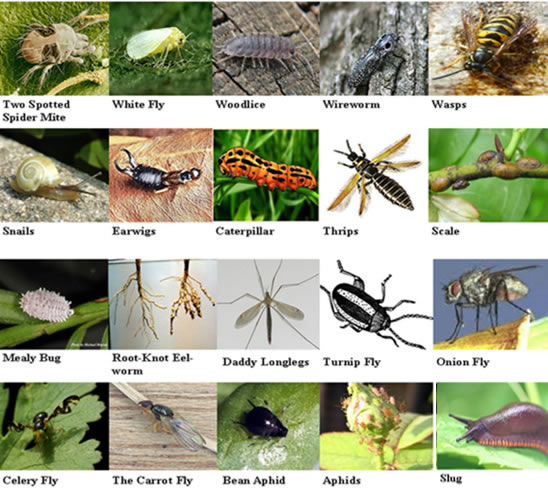We carry out the following typical steps in the integrated farm pest management process;
The pictures below illustrates the most common farm pests;


- Proper identification of problems
Our IPM approach promotes “proactive” rather than “reactive” management. Correct identification is the first and most important step in controlling a field problem. This first step is critical to future success, since an incorrect diagnosis leads to mismanagement. What is causing the problem? A pest? An environmental stress? A nutritional deficiency? Or some another factor or combination of factors. We will also identify parasites and predators that help keep harmful pests in check.We will strive to answer the following questions; what type of damage is observed? Check field history information if available to determine if it is a historical problem? Is the problem found only in particular locations, rows, soil types, drainage patterns, or at certain times? During the growing season? What part or growth stage of the plant is affected?We will dig up plants showing symptoms. Check roots and the surrounding soil for evidence of pests. If in doubt about correct identification of the problem, we will collect representative samples and field information to share with other knowledgeable persons or submit to a diagnostic clinic. We have many resources available to provide helpful information on identification of common pest problems of crops.
- Sampling to determine the extent of the problem
Once the pest is correctly identified by Jannakill Pest Solution Technicians, the next question which we will strive to answer will be; Is there a risk of significant loss? Is the problem occasionally seen? Localized? Or commonly found throughout the field? What is the extent of the damage? Is the problem a growing threat? We will utilize scientific sampling / crop monitoring techniques which have been developed for assessing the damage potential of many pests. Correct sampling helps eliminate the guesswork in pest control by providing a means to quantify an old problem or discover a new one. We will use sampling knowledge and information on pest and crop biology to make better management decisions. We will examine and quantify all important field information needed to make a sound pest management decision.We will apply Pest Forecasting – For some pests forecasting methods have been developed to aide in determining when a pest is likely to be a problem. Weather data and other information help predict when these specific pests will most likely occur. Weather-based pest forecast models for diseases and insects of many crops have been developed. - Analysis to assess problem importance
The third step in the pest management process will be analyzing the identification and sampling information and evaluating the need for a pest control action. We will decide how bad the problem really is. We will assess whether the potential control measure is more costly than the damage potential? We will weigh economic, environmental, and time concerns. We will assess the impact of the current pest control decision on future crop management decisions?During the analysis stage, we will consider the relative vigor of the plants, plant populations, and value of the crop and potential yield. - Selection of appropriate management alternative
When an action is needed, we will choose a strategy that fits with the short- and long-term plans, labor force, capital, equipment, and finances of the farm. We will evaluate the costs, benefits, and risks of employing various management options. We will look for opportunities to integrate different pest control strategies. We will determine the cultural, mechanical, biological and chemical control options? We will also determine which is the most practical, economical, effective choice?
The following are examples of management tactics which we can employ;- Biological – Parasites, predators, pest
- Chemical – Pesticides, pheromones, baits, attractants
- Cultural – Rotation, planting date, site selection, fertility, pH, plant populations, sanitation
- Host Resistance – Resistant Varieties, Transgenic Crops
- Mechanical – Cultivation, Tillage, Rotary Hoe, Fly Swatter, Traps, Screen, Fence
- Physical – Rain, Freezing, Solar Radiation
- Proper implementation of management action
We will implement the control carefully and at the right time. If pesticides are used, we will always follow label recommendations. Cultivation or using herbicides on weeds must be done at the right stage of weed and crop development for greatest impact. We will Pay close attention to the quality control of pest control actions, such as correct calibration of the application equipment and label recommendations. If appropriate, we will leave small, untreated areas to evaluate control effectiveness. We will conduct management action with precision and thoroughness. - Evaluation of effectiveness of management action
After a pest control action is taken, we will review what went right—and equally as important, what went wrong or could be improved. We answer the question; Did the control work? Scout the field again and compare pest activity before and after treatment. We will determine if the problem was identified properly? We will determine if the choice of control was based on sound judgment or outside pressure? We will determine what changes to the system would make it better? This evaluation step is a very important part of the IPM process since it enables us to learn from experience and find ways to improve management skills and impact.
